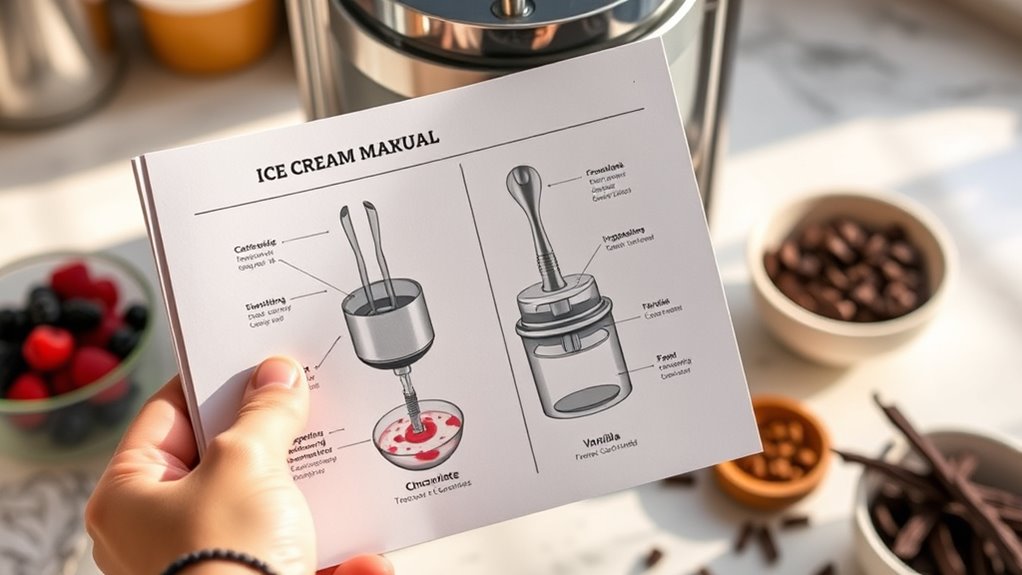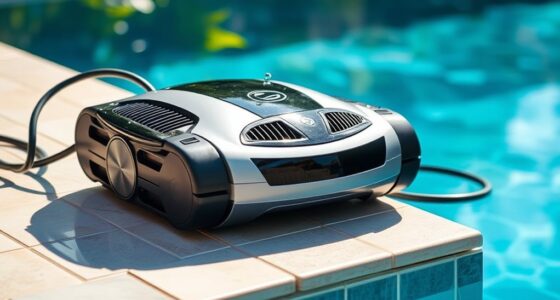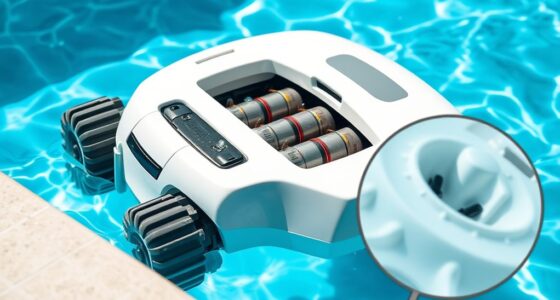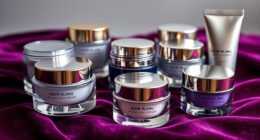If you’re confused by ice cream maker terms, it’s helpful to know that churning means mixing the ingredients to add air and guarantee a smooth texture, while freezing transforms your mixture into the final scoopable treat, controlling ice crystal size. Paddles and agitators work to keep the mixture moving, preventing ice chunks. Compressor models keep things cold nonstop, while freezer bowl types need pre-freezing. Understanding overrun, texture, and features can make your ice cream experience much easier—if you keep going, you’ll master the details.
Key Takeaways
- Overrun measures how much air is whipped into the ice cream, affecting its lightness and creaminess.
- Churning involves mixing ingredients to incorporate air and prevent large ice crystals, crucial for smooth texture.
- Compressor models have built-in refrigeration for continuous operation, unlike freezer bowl types that require pre-freezing.
- Texture preferences like gelato or soft serve depend on overrun levels and ingredient mixing, influencing density and creaminess.
- Agitator and paddle design impact how ingredients are mixed and aerated, directly affecting the final ice cream’s consistency.
Understanding the Churning Process
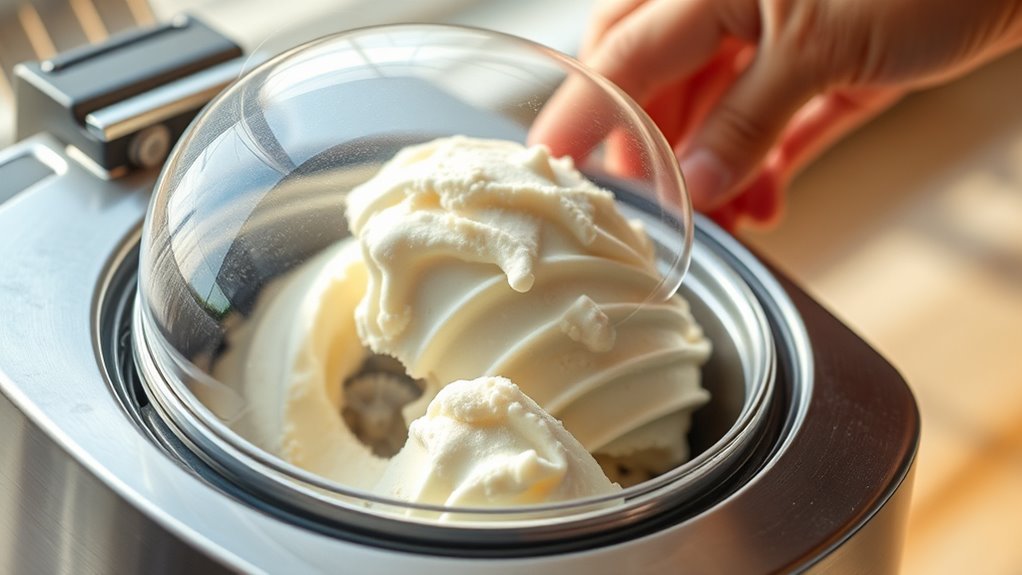
Understanding the churning process is essential to making smooth, creamy ice cream. When you churn, you incorporate air into the mixture, giving your ice cream its light texture. This step also helps with flavor customization, allowing you to add mix-ins like fruit or chocolate at just the right moment. Proper churning guarantees the mixture doesn’t freeze into a solid block, making scooping easier. It also impacts your storage solutions; well-churned ice cream stays soft enough to serve straight from the freezer. If you over-churn, your ice cream can turn icy or grainy. Under-churning results in a dense, less creamy texture. Additionally, the churning process in ice cream making influences the final product’s texture and quality, which are crucial for achieving that perfect creamy consistency. Knowing the churning duration helps prevent common issues like iciness or creaminess loss, making your ice cream truly professional-quality. Properly monitoring churning time ensures you achieve the optimal balance between softness and firmness.
What Does Freezing Mean in Ice Cream Making?
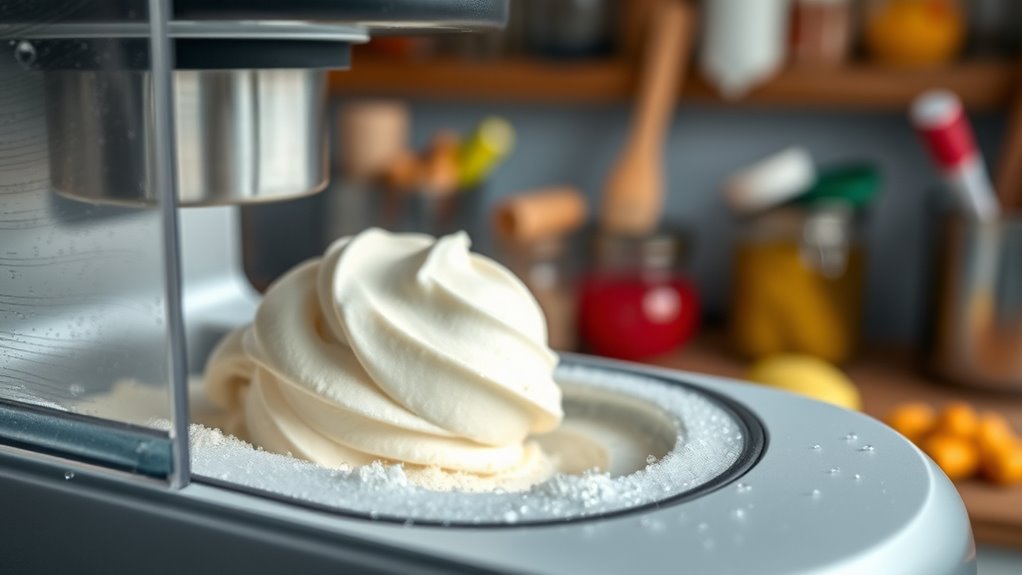
Freezing in ice cream making involves transforming your liquid mixture into a firm, scoopable dessert by lowering its temperature to create ice crystals. During this process, sugar crystallization occurs, helping control the size of the ice crystals and ensuring smoothness. Proper freezing also enhances flavor infusion, allowing the ingredients to meld and develop richer tastes. As the mixture cools, the reduction of liquid water forms tiny ice crystals that give ice cream its texture. If freezing happens too quickly or unevenly, larger crystals can form, making your ice cream icy or gritty. Achieving the right freeze ensures a perfect balance between creaminess and firmness, highlighting flavors and maintaining a desirable consistency. Cookies play a role in controlling how the freezing process impacts texture and flavor development. Additionally, understanding industry transformations, such as advances in freezing technology, can help improve your homemade ice cream’s quality and consistency. Proper temperature control during freezing is crucial for optimizing contrast ratio and overall texture, ensuring a superior dessert experience.
The Role of Paddles and Agitators
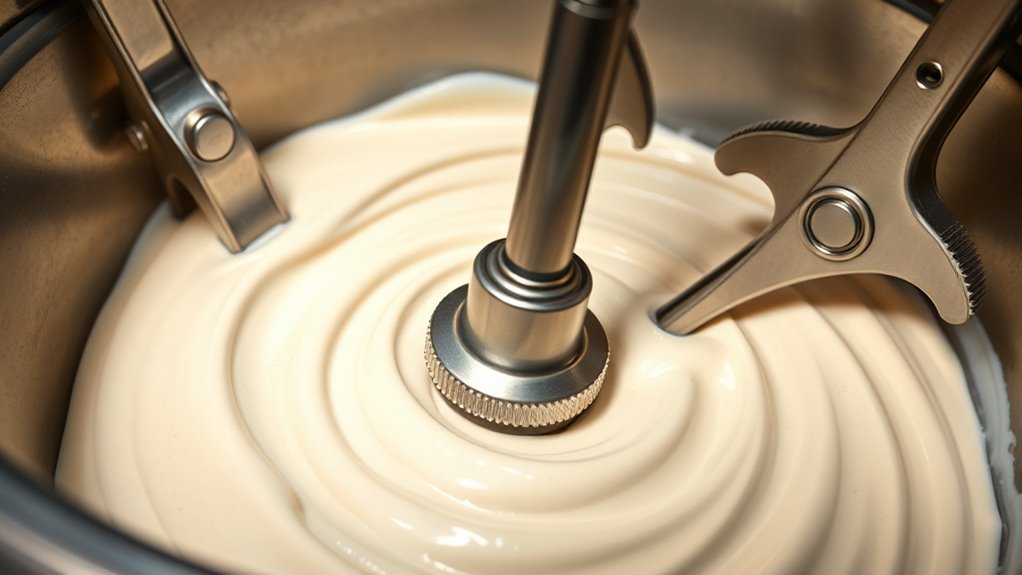
Your ice cream maker’s paddles and agitators are essential for mixing ingredients evenly. They influence the final texture by preventing ice crystals from forming and ensuring smoothness. Different designs can improve efficiency and consistency, making your ice cream just right. Incorporating professional equipment can also enhance the quality of your homemade ice cream. Selecting the right mixing components can further optimize the texture and taste of your frozen treats, especially when considering the importance of proper maintenance to keep the parts functioning effectively. Regular upkeep ensures that the equipment functions efficiently and maintains optimal performance over time, reducing issues such as clogging or uneven mixing.
Function of Mixing Blades
The mixing blades inside an ice cream maker play an essential role in ensuring your frozen treat turns out smooth and creamy. These blades, often called paddles, are designed to continuously churn the mixture, preventing ice crystals from forming and ensuring even freezing. The paddle design is key because it influences how well the ingredients combine and how effectively air is incorporated, which affects texture. As the blades rotate, they scrape the sides of the container, mixing in ingredients evenly and maintaining a consistent consistency. Properly functioning mixing blades prevent the formation of large ice chunks, leading to a richer, smoother ice cream. The effectiveness of the paddles depends on the quality of the blades or agitators, which are crucial for achieving the desired creamy texture. Regular maintenance and proper cleaning of the paddles ensure optimal performance and prevent buildup that can hinder mixing efficiency. Without these blades working efficiently, your frozen dessert could end up icy or grainy instead of velvety and delicious. Additionally, using protective measures during cleaning can extend the lifespan of the paddles and maintain their optimal performance. Ensuring proper alignment of the paddles can also improve mixing efficiency and prevent uneven freezing, which is vital for a consistent product. When selecting replacement parts, always consider the material quality to ensure durability and consistent results.
Impact on Texture
The way paddles and agitators are designed directly influences the texture of your ice cream. They help create a smooth, creamy consistency by ensuring ingredients are properly mixed and aerated. Proper agitation enhances flavor by evenly distributing ingredients, preventing pockets of unmixed components that can affect taste. Additionally, effective paddles facilitate ingredient integration, breaking down larger pieces and blending flavors seamlessly. If the paddle design is too aggressive, it might produce a dense or icy texture, while gentle agitation results in lighter, creamier ice cream. Understanding ice cream textures can help you select the right equipment for perfect results. The design and movement of paddles also impact how well the ingredients are incorporated, influencing overall quality. Proper paddle design can also reduce over-processing and minimize air incorporation, which affects the final texture. Incorporating knowledge of professional equipment can further refine your ice cream making process. Ultimately, the design of these components plays an essential role in achieving the desired texture and flavor profile.
Design Variations
Design variations in paddles and agitators considerably impact how ice cream is churned and textured. Different designs influence how evenly the ingredients mix, affecting the final ice cream flavor and creaminess. Some paddles are more efficient at incorporating air, resulting in lighter textures, while others focus on dense, rich results. The shape and movement of agitators also determine how well the ice cream cools and blends. If you want a portable machine, look for compact agitator designs that maximize efficiency without sacrificing texture. Additionally, certain paddle styles can enhance flavor infusion, making each batch more delicious. Whether you prefer a smooth, creamy consistency or a more textured treat, design variations play a key role in achieving your ideal ice cream experience.
Compressor vs. Freezer Bowl Models

Compressor ice cream makers have a built-in refrigeration system that cools the mixture as it churns, allowing you to make multiple batches without any pre-freezing. This convenience means you can experiment with different ice cream flavors back-to-back, since you don’t need to wait for the bowl to freeze. They generally offer larger storage capacity, making them ideal if you want to make big batches or keep extra ice cream on hand. In contrast, freezer bowl models require you to pre-freeze the bowl for several hours before use, which limits your flexibility. While freezer bowl machines are often less expensive and more compact, compressor models provide continuous operation and faster turnaround times, perfect for frequent ice cream lovers. Additionally, compressor models often feature more advanced controls, allowing for precise temperature adjustments to achieve the perfect texture. Incorporating automation in business can also lead to more efficient manufacturing processes, similar to how compressor models streamline ice cream production.
The Significance of Overrun and Texture
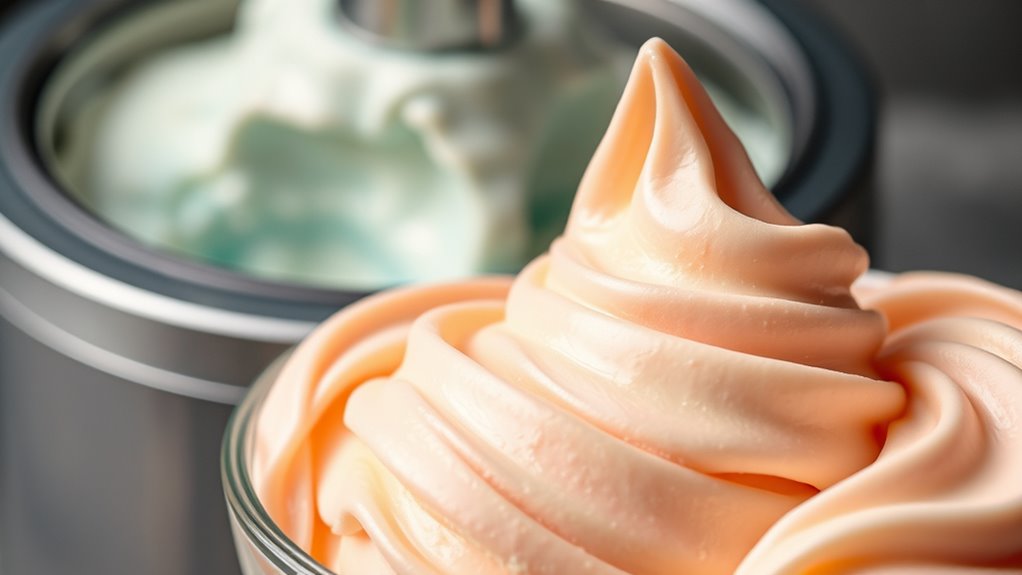
The amount of overrun directly affects how creamy and airy your ice cream feels, shaping your overall experience. Texture also plays a vital role in enjoyment, influencing how smooth or chunky each bite is. Finding the right balance between overrun and texture ensures your ice cream is both light and satisfying.
Overrun’s Effect on Creaminess
Overrun, which measures how much air is whipped into the ice cream during churning, plays a crucial role in determining its creaminess and texture. Higher overrun creates a lighter, fluffier product, while lower overrun results in a denser, richer ice cream. The overrun’s influence directly impacts how smooth and indulgent your treat feels on the palate. When the overrun is just right, it enhances the creaminess without sacrificing flavor or body. Too much air, however, can make the ice cream feel icy or insubstantial, diminishing its creaminess enhancement. To get the perfect balance, consider these points:
- Ideal overrun boosts smoothness and mouthfeel
- Excessive overrun leads to a frosty, less creamy texture
- Lower overrun creates a dense, luxurious feel
- Proper overrun enhances overall creaminess and enjoyment
Texture’s Impact on Enjoyment
Since texture directly influences how enjoyable your ice cream is, achieving the right balance is essential. Gelato vs. ice cream differs mainly in texture; gelato is denser and creamier because it contains less air, or overrun. This creates a richer mouthfeel and more intense flavor. Soft serve differences are notable too; soft serve has higher overrun, making it lighter and airier with a smoother texture. Your preferred texture impacts your enjoyment—some prefer the velvety richness of gelato, while others enjoy the fluffy lightness of soft serve. Understanding these distinctions helps you select the right type for your taste. Ultimately, the right texture enhances your overall experience, making each scoop more satisfying and memorable.
Balancing Overrun and Texture
Balancing overrun and texture is essential because it directly affects the creaminess and mouthfeel of your ice cream. Too much overrun can make it light and airy, sacrificing richness, while too little results in dense, heavy ice cream. Achieving the right balance allows you to optimize flavor customization and ingredient flexibility, creating a product that suits your preferences.
Consider these points:
- Adjusting overrun levels influences how smooth or fluffy your ice cream feels.
- Higher overrun can incorporate air for a lighter texture, but may dilute flavor.
- Lower overrun preserves richness, enhancing ingredient flexibility for bold flavors.
- Finding the sweet spot balances fluffiness with creaminess, ensuring a satisfying mouthfeel.
How to Read an Ice Cream Maker Manual
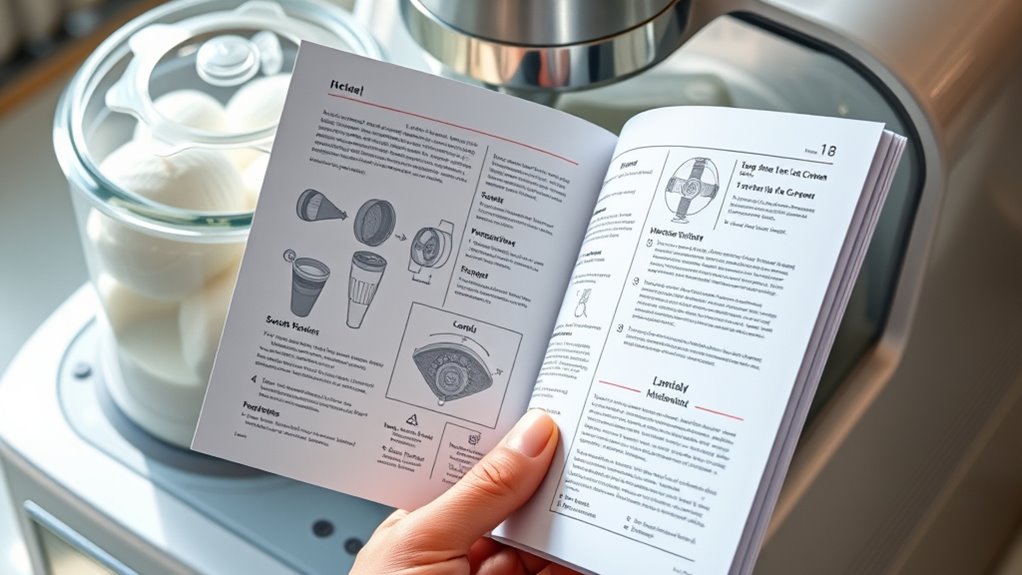
Have you ever felt overwhelmed trying to understand an ice cream maker manual? Don’t worry—reading it carefully is key. Start by identifying sections on ingredient substitutions; these help you adapt recipes if you’re missing something. Look for maintenance tips to keep your machine running smoothly and avoid breakdowns. Pay attention to safety instructions, assembly diagrams, and cleaning procedures. Manuals often include troubleshooting advice for common problems, which can save you time and frustration. Highlight or note important details, especially if you plan to modify recipes or perform regular upkeep. Understanding how to interpret these instructions guarantees safe operation and better results. With patience, you’ll gain confidence in using your ice cream maker and making delicious treats effortlessly.
Common Features and Accessories Explained
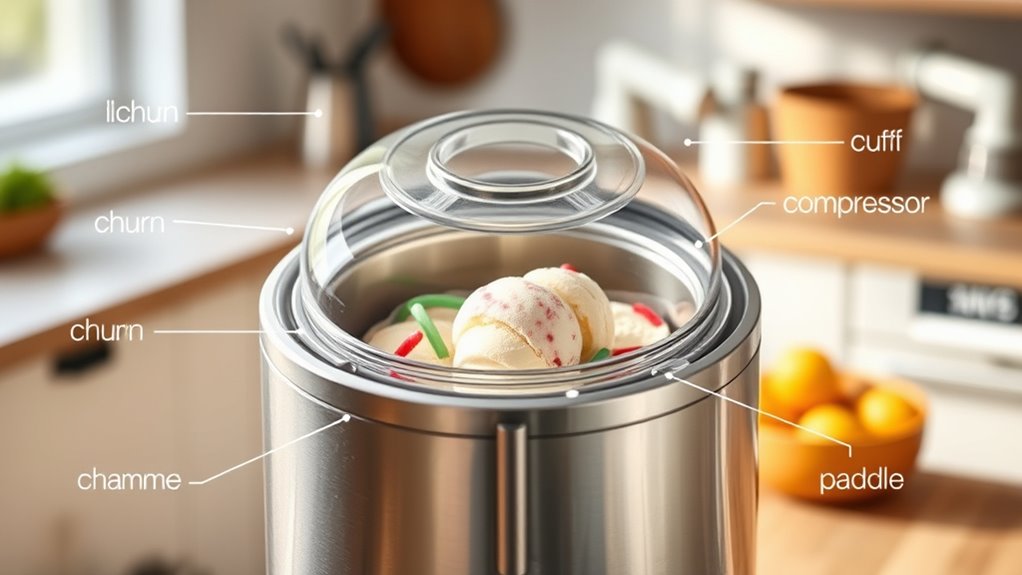
Understanding the common features and accessories of your ice cream maker can enhance your experience and expand your options. Many models come with adjustable speed controls, built-in timers, and easy-clean surfaces to simplify your process. Additional accessories often include multiple ingredient compartments, so you can add different flavors or mix-ins without mixing everything together. Some machines feature pre-set flavor options, giving you creative flexibility. Others have freeze bowls or paddles that help achieve the perfect texture. By knowing these features, you can customize your ice cream creations to suit your taste. Whether experimenting with ingredient compartments or exploring flavor options, understanding what your machine offers allows for more fun and variety in your frozen treats.
Frequently Asked Questions
Can I Make Dairy-Free Ice Cream With Any Machine?
You can make dairy-free ice cream with many machines, but check if yours is compatible with dairy-free ingredients. Some ice cream makers require pre-freezing bowls or special attachments, so alternative freezing methods like using a regular freezer may work. Just verify your machine can handle ingredients like coconut milk or almond milk. With the right equipment and dairy-free ingredients, you’ll enjoy delicious, homemade dairy-free ice cream anytime.
How Long Does It Typically Take to Churn Ice Cream?
Ever wonder how long you’ll wait before that creamy goodness appears? The churn duration varies, but typically, it takes about 20 to 40 minutes to make ice cream. During this freezing time, you’ll notice the mixture thickening, transforming into soft serve. Patience is key—if you rush, it won’t reach the perfect consistency. Keep an eye on the clock, and soon you’ll savor your homemade treat!
Are All Ice Cream Makers Suitable for Gelato or Sorbet?
Not all ice cream makers are suitable for gelato or sorbet. If you’re aiming for gelato compatibility, look for machines with slow churning speeds to attain that dense, creamy texture. For sorbet suitability, choose models that handle fruit and juice-based mixes well and can operate at colder temperatures. Check the specifications to make sure your machine can handle these types, so you get the best results every time.
What Maintenance Is Required for Different Ice Cream Maker Types?
You’ll want to treat your ice cream maker like a prized treasure! Regular cleaning routines are essential—don’t skip them, or your machine might turn into a gooey mess. Storage tips matter too; keep parts dry and protected from dust. For different types like compressor or manual models, follow manufacturer instructions for maintenance. This way, you guarantee smooth, delicious results every time and keep your machine humming happily for years!
How Do I Prevent Ice Crystals From Forming in My Ice Cream?
To prevent ice crystals from forming in your ice cream, focus on minimizing air bubble formation during churning and ensuring proper storage temperature. Keep the mixture at a consistent, cold temperature before freezing, and avoid opening the freezer frequently. Using an airtight container helps maintain the right environment, reducing moisture exposure. These steps help your ice cream stay smooth and creamy, free of unwanted ice crystals.
Conclusion
Now that you’ve decoded the ice cream maker terms, you’re ready to create your perfect batch. Think of it like mastering a recipe—once you understand each ingredient and step, the process becomes second nature. I remember my first attempt, nervously watching the churning, and realizing it’s like riding a bike: a little wobble at first, but soon, you’re gliding smoothly. With these insights, you’ll be whipping up delicious ice cream in no time!
